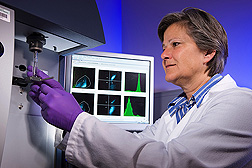Cancer-Fighting Roles of Intriguing Plant Compounds
|
|
An array of studies from scientists at the Agricultural Research Service’s Western Human Nutrition Research Center in Davis, California, is yielding new clues about the roles that compounds from plants may play in preventing cancer and other diseases.
For example, molecular biologist Susan J. Zunino has investigated the role that certain compounds in strawberries may have in combating cancer. Her tests with lab-cultured cells of a cancer known as “acute lymphoblastic leukemia” have provided additional evidence that three compounds occurring naturally in strawberries—ellagic acid, kaempferol, and quercetin—can cause death, or significant damage, to certain lines of these leukemia cells.
The compounds’ modes of action vary, as does their effectiveness, Zunino and coresearchers found. Each strawberry component was extracted and purified and then tested separately in a succession of doses extending over a 72-hour period.
The scientists point out that several key questions still need to be answered. Among them: Are the compounds as effective in humans as they are in lab-cultured cells? How bioavailable are the phytochemicals, that is, what amounts do our bodies actually take up, and use, from the foods that we eat?
Zunino and her ARS colleagues collaborated in the studies with medical researchers at the University of California-Los Angeles and published their findings in the Journal of Functional Foods in 2009. ARS and the Watsonville-based California Strawberry Commission funded the studies.
ARS colleague Daniel H. Hwang, also a molecular biologist at Davis, investigates the ability of plant chemicals to protect us from harmful inflammation. Unwanted inflammation can increase risk not only of cancer, but also of certain other disorders, including heart disease and insulin resistance.
Hwang and a team of coinvestigators have teased out precise details of how six natural compounds in plants—luteolin, quercetin, chrysin, eriodicytol, hesperetin, and naringenin—apparently act as anti-inflammatory agents.
Luteolin is found in celery, thyme, green peppers, and chamomile tea. Foods rich in quercetin include capers, apples, and onions. Oranges, grapefruit, lemons, and other citrus fruits are good sources of hesperetin, eriodicytol, and naringenin. Chrysin is from the fruit of blue passionflower, a tropical vine.
The scientists have provided new, specific, and previously unknown details about how these phytochemicals work indirectly to undermine and inhibit the expression of certain genes. Without that interference, the products of those genes might—in turn—trigger inflammation.
It’s research that involves determining how the plant compounds send biochemical signals downstream, along some of the body’s complex pathways. Then, researchers have to determine which molecules along the pathways are the phytochemicals’ intended targets.
Hwang’s team has shown, for the first time, that all six plant compounds target an enzyme known as “TBK1.” Each compound inhibits, to a greater or lesser extent, TBK1’s ability to activate a specific biochemical signal. If unimpeded, the signal would lead to formation of gene products known to trigger inflammation.
Of the six compounds, luteolin was the most effective inhibitor of TBK1. Luteolin is already known to have anti-inflammatory properties. But Hwang and his colleagues were the first to provide this new, mechanistic explanation of how luteolin exerts its anti-inflammatory effects.
What’s more, the approaches that the researchers developed to uncover these compounds’ effects “can also be used, in the future, to identify additional anti-inflammatory compounds present in fruits and vegetables,” Hwang notes.
The scientists’ 2009 article in Biochemical Pharmacology has details.
The study expands on earlier work in which Hwang and colleagues provided a close-up look at how other plant chemicals also act as chemoprotectants by interfering with the flow of other biochemical signals.
Ongoing studies by Zunino and Hwang will yield even more insights into the phytochemicals that defend us against disease.—By Marcia Wood, Agricultural Research Service Information Staff.
This research is part of Human Nutrition, an ARS national program (#107) described at www.nps.ars.usda.gov.
To reach scientists mentioned in this article, contact Marcia Wood, USDA-ARS Information Staff, 5601 Sunnyside Ave., Beltsville, MD 20705-5129; (301) 504-1662.
"Cancer-Fighting Roles of Intriguing Plant Compounds" was published in the July 2010 issue of Agricultural Research magazine.







